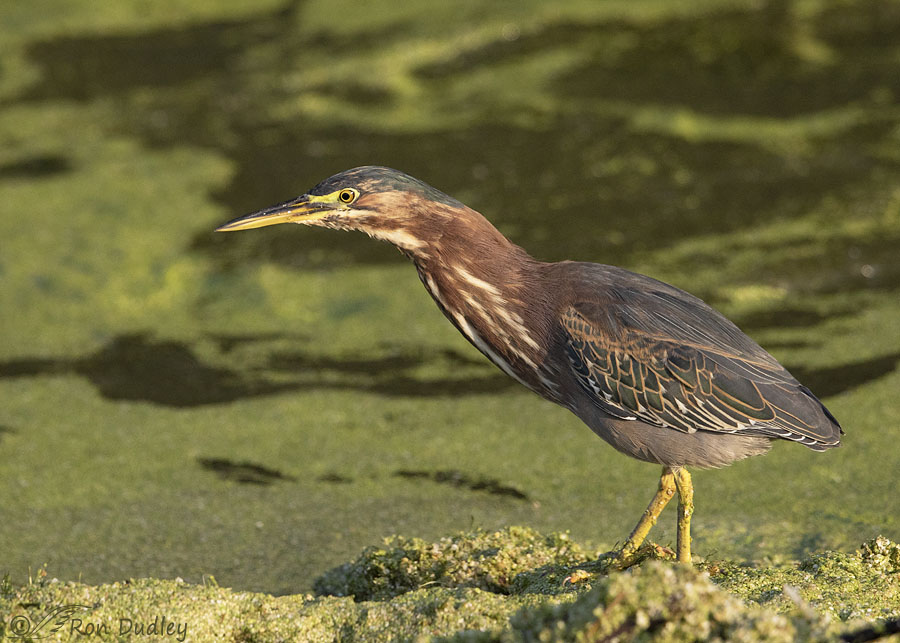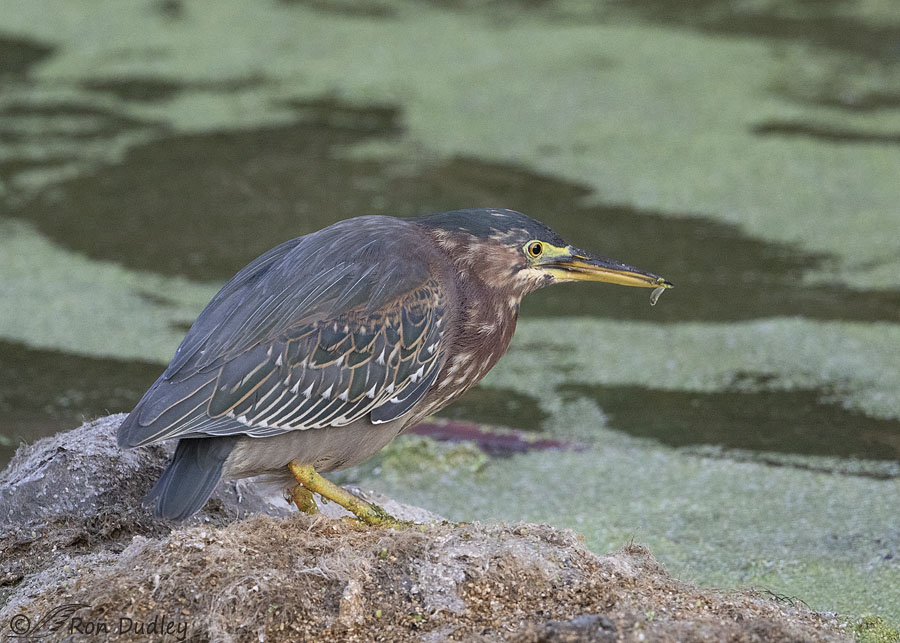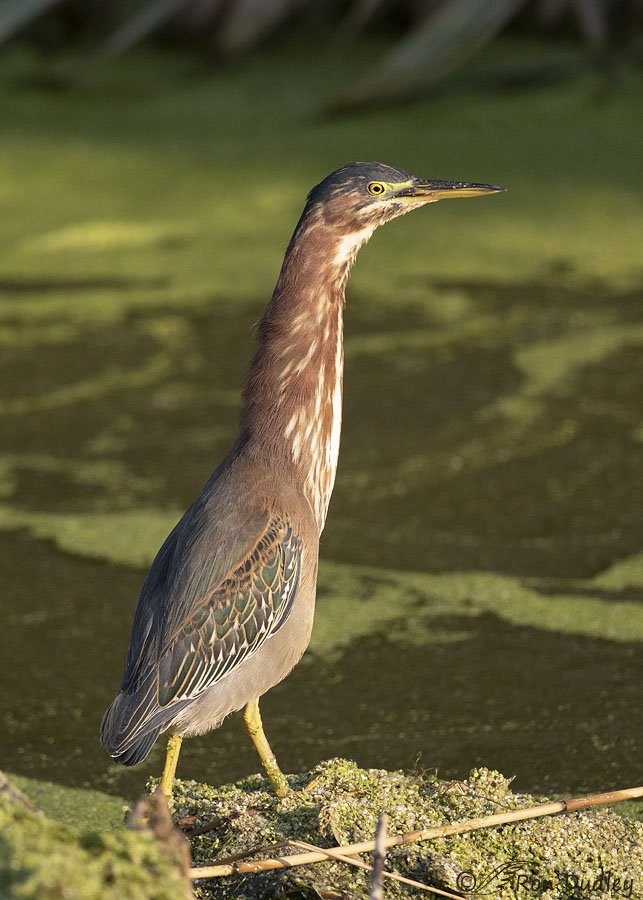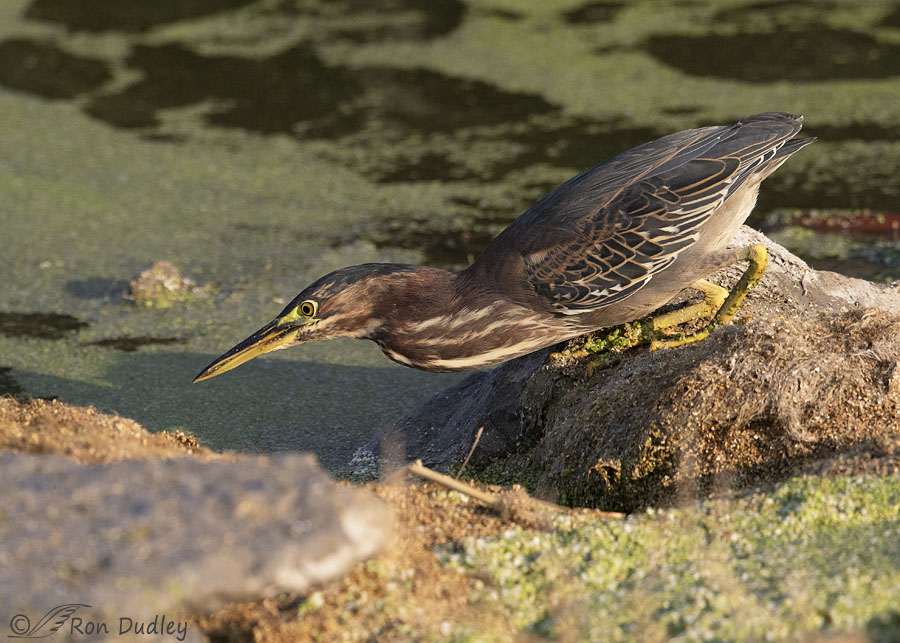This heron was a lifer for me.

Technically Green Heron’s aren’t considered to be rare in Utah but they’re close and until six days ago when I photographed this sub-adult at Farmington Bay WMA I’d never even seen one, much less been able to get one in my viewfinder.
This bird was fishing in the relatively fast flowing duckweed-covered water next to a bridge which accounts for the rather unusual background. While I was watching ‘him’ through my lens the contrasty patterns of bright green duckweed and dark water swirling through the background actually made me a little dizzy. It was a weird feeling to say the least.

He specialized in tiny fish as we see in this photo taken while he was in the shade.

At one point he came in so close to me I had to shoot vertically when he stood erect.

I took a long series of photos of him in this tensed-up posture after he’d spotted a fish but before he struck at it. When I study this shot it almost appears to me like he’s defying the laws of gravity. His center of gravity seems to be so far forward that he should topple over on his face but he didn’t. And this isn’t a motion shot where he’s in the process of striking, I have at least a dozen photos of him in this position.
I realize that his upper leg attachment to his body is further forward than it might appear, but still…
After 13 years of looking for and photographing birds I rarely get a lifer anymore so the 56 minutes I spent with this heron was a hell of a lot of fun.
Ron


Congrats on your lifer! I love Green Herons. I thoroughly enjoyed this series. Thanks for sharing.
Love how the sun is reflecting on the gorgeous colorful plumage in the 3rd shot. The Have never seen this bird!
Wonderful discussion and learning as usual! Glad you’re home Laura!
Glad you’re home Laura!
These are really great shots of this nice Green Heron, Ron.
Glad you got the great opportunity with the nice background.
I’m lucky to have them as regulars around here but I always count it as special when I encounter one, camera or none.
I find it difficult sometimes to edit their patterned body plumage as I have difficulty in adjusting it to show as true to life as I would like to attain. What settings were you using on some of these shots?
Thanks, Dave. As an example my settings for the third shot were 1/2500, f/5.6, ISO 800.
Such a beautiful specimen! All of his greens and the green duckweed — wonderful!
Glad you didn’t have any experience with the colloquialism.
Thanks, Marty.
Wonderful photos and all the green fits the bird! I love the vertical stretched out neck.
I looked for him today, no luck.
April, I had friends from out of town looking for him yesterday but they didn’t find him either.
I look at that posture and start to imagine the muscular control (and strain) in holding that position. For even a nanosecond without toppling over.
You noted that only tiny fish were taken – which must require almost constant fishing to survive.
Thank you and your commentators for giving me something wonderful to kickstart the day with.
EC, I only saw him take tiny fish but I imagine they eat larger fish too. After all, they’re herons.
My favorite heron The defying gravity pose is the one I frequently see them in as they are very intent on looking for fish. Baiting is a well-known behavior for them, placing some bright object on the water’s surface and waiting for a curious fish to come investigate. Shitepoke was mentioned as a colloquial name for them. This comes from another behavior. “Poke” often refers to any heron. These birds frequently defecate upon take off, so Chalkline is another colloquial name used. Shitepoke is simply a polite spelling of the real nickname used. They sometimes launch themselves completely into the water looking like they accidentally fell into the water. This seems to be a deliberate action and often results in the capture of a small fish.
Loved your detailed description of the origin of ‘shitepoke’, Dan. I’m going to file that one away for future (creative) use…
I have so much to learn, and so little time! Here in the midwest, in the first few decades of the 1900s, the country folk would sometimes eat green heron, usually only if they came upon them when they were hunting frogs and crawdads along the creeks. The way they said the word, i thought they were saying “shy-poke”, with a glottal stop after ‘shy’. It took me awhile today to find the common spelling.
I had no idea folks ever ate Green Heron!
There was a time when it was illegal in Missouri to hunt deer because the numbers had been driven down so far. I’ve read about it but I can’t recall the exact timing of it. So, that compounded with the Depression, large farming families would eat small game along with what they grew. They didn’t starve ever, but most of them would gladly eat a squirrel or a bird, if they had it, with the cornbread and beans.
There is so much amazing beauty on our planet and once again, you’ve captured it! Congrats on your lifer! That’s so exciting!!
As for gravity, our laws don’t often pertain to other critters. They don’t believe in it and thus, they don’t always have to listen to it.
Back when these birds were abundant in my environment I hadn’t gotten to where I discovered my passion for them. I hadn’t yet learned to appreciate them and the magic they bring to my life. That saddens me, but it happened.
And yeah, these guys (birds in general) are living dinosaurs! They learned to adapt and thrive in their new environment and here they are. There are lessons for humans there. Alas, most of us are oblivious.
And let me repeat what Kaye said. “Thank you for making my life better every day.” Just so you know, you’re an outrageous blessing in so many different ways. Thank you just doesn’t get there, but it’s the best our language will do.
One more thing, Dorothy was right! There’s no place like home!!!
I hope you’re having a wondrous day!
Very kind of you to say so, Laura.
And WELCOME HOME!
WONDERFUL news Laura. Really wonderful.
What terrific photos! In the last photo it looks like he just has his toes ‘scrunched down’ so very tightly as to not lose his balance. Wonder if they have the grippers that wood ducks have… The third photo reminds me of an American Bittern with the way he is standing. Congrats on all these photos. I saw my first Green Heron last year and I remember the excitement well.
Yes, I see the resemblance to a Bittern that you mention, Kathy. It’s fairly striking in that photo.
Your green heron pictures are fabulous. Living on the east coast of FL they are in abundance. Often see them in roadside ditches looking for fish or insects. You’d be in heaven.
You’re right, I would, Barbara.
You are a true artist. Thank you for making my life better everyday.
Kaye
Park City, UT
Thanks very much, Kaye.
Ron, around these parts, 60 years and more back, everyone called this bird shitepolk. Sounds Irish to me. When you get a chance, you should watch a video from January 2010 Field and Stream, in the story “Merwin: Even Birds Use Bread for Bait”. (I can paste the weblink if you can’t find it with this information.) That green heron is using bread for bait.
Nina, Dan has explained the origin of ‘Shitepolk’ in his comment above.
I’ve seen several different videos of the fascinating fish-baiting behavior of Green Herons.
Excellent series Ron. They are listed as uncommon here and although we have five lakes I have only seen and photographed one and it was at least ten years ago. I still look for them, but not very hopefully.
Everett, I would be surprised if it’s 10 years before I see another one. If I ever do.
That’s a very long time to spend with a Green Heron. We have them here in the Pajaro Valley/Monterey Bay, but they are ‘aggressively shy’ about getting their portraits taken.
Dan, I could have spent even more time with him but he went back into the shade so I left the area.
I’ve never seen one – their range is far S of here. Generally rather illusive hiding in reeds as I understand it. Wonderful series and it doesn’t look like he should be able to hold that position! Beautiful bird even if “strange” looking. Great to be able to spend that amount of time with an unusual (to you) bird when “birding” has been so lousy of late……..
Great to be able to spend that amount of time with an unusual (to you) bird when “birding” has been so lousy of late…….. 
Judy, you mention another reason I was so happy to see this heron – birds have been pretty darn slow around here lately.
They’ll sit in that last position on dock lines in our marinas, only a few inches above the water and with their bill nearly touching it. It’s the most extraordinary thing to see, especially when they strike at a fish and even then don’t lose their balance. Great photos of this one!
Thanks, Shoreacres. Extraordinary indeed.
I saw a mention of their fishing techniques in another comment. It’s true: they use bread, feathers, insects, and other detritus as bait. I’ve watched them do it.
I had never seen it; they’re very shy around here. So, then, some bird at some time learned to fish with bait, and it’s been passed on to the next generation… for how many generations I wonder?
My observations agree with shoreacres – that tipped over fishing position is the most common way I have seen them. They are often on logs or other things sticking out of the water. The unusual pose for me in the photos is the stretched neck posture you captured. He must have been very interested in observing you.